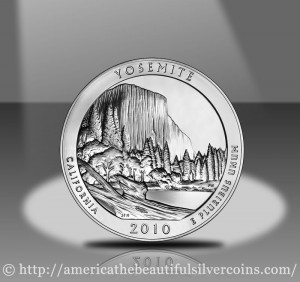Released as the third .999 fine silver coin in a series from the US Mint was the 2010 Yosemite America the Beautiful Silver Uncirculated Coin. Yosemite National Park of California is represented by this strike with a design shown on its reverse.
The United States Mint initially offered this strike for sale to the public on June 9, 2011 with a maximum mintage of just 27,000 coins. This strike took longer to sell-out than the previous two of the series, but sales of the strikes reached the mintage cap on July 20, 2011 officially leading to a sell-out.
This coin is the third of five 2010-dated strikes in the US Mint’s America the Beautiful Five Ounce Uncirculated Coin series. These coins serve as the numismatic versions of the similar America the Beautiful Silver Bullion Coin™ Program, also from the Mint. However, whereas the bullion coins are struck to bullion quality for investors and feature no mintmark, these uncirculated coins are struck to a collector grade finish and feature a P mintmark indicated they were struck at the US Mint’s facility in Philadelphia.
Both series of coins contain five ounces of .999 fine silver and were struck to a diameter of three inches. Also an edge inscription was placed on each coin indicating their weight and fineness of .999 FINE SILVER 5.0 OUNCE. These specifications were required for the bullion coins as part of the original act that authorized them, the America’s Beautiful National Parks Quarter Dollar Coin Act of 2008. New legislation has changed those requirements, however, which could result in future years strikes omitting the edge inscription and having a diameter somewhere in the range of 2.5 inches to 3.0 inches.
Also, both silver coin series feature obverse and reverse designs similar to the circulating America the Beautiful Quarters® Program. This means that the obverse of each strike will include a portrait of the first President of the United States, George Washington. The portrait was originally designed by John Flanagan for the 1932 circulating quarter dollar and has been in use on the quarter ever since.
The reverse designs in the series are to be emblematic of the selected site of national interest. As such, the reverse of the Yosemite coins feature a reverse design showcasing Yosemite National Park of California as designed by Joseph Menna and sculpted by Phebe Hemphill. It shows the iconic granite monolith known as El Capitan which rises over 3,000 feet above the valley floor below.
The Mint will typically release five of the America the Beautiful Silver Uncirculated Coins annually. However, owing to a short lead-time before the start of the program and initial production difficulties, the release of the 2010 dated strikes will not occur until the first part of 2011.
These coins were sold directly to the public by the US Mint. In contrast, the sister series of bullion coins are sold through the Mint’s network of authorized purchasers.
Yosemite National Park in California
Yosemite National Park was originally granted some federal protection on June 30, 1864 when President Abraham Lincoln signed the Yosemite Grant. However, the Grant fell short of true preservation and efforts were enhanced to redesignate it as a national park. Those efforts were successful and Yosemite National Park was created on October 1, 1890. Its management was the responsibility of the U.S. Army until 1916 when Congress created the National Park Service.
The park itself consists of 761,268 acres, however most of the estimated 3 million plus annual visitors spend their time in the scenic, but accessible Yosemite Valley. This valley was cut into the landscape by the Merced River and is only approximately eight miles long by one mile wide.
However, many of the park’s famous icons can be viewed best from within the valley. This includes the massive granite cliffs of El Capitan, Half Dome and Cloud’s Rest. Some even attempt to climb the steep cliffs which can reach heights in excess of 3,000 feet.
Others visit solely for the scenery which includes a dense pine forest and hundreds of different other species of plants and animals. Some of the more intriguing creatures within the valley include the American black bear, bobcats and coyotes, but other creatures such as the Mountain Chickadee, the White-Headed Woodpecker and the rattlesnake may also be spotted.
